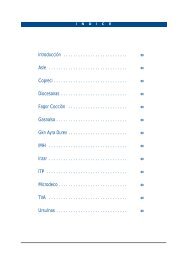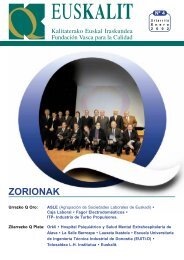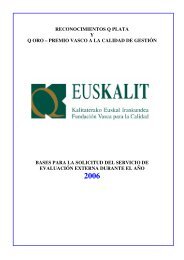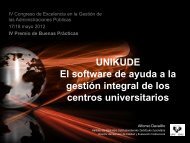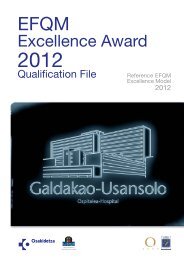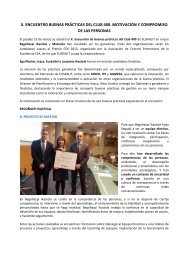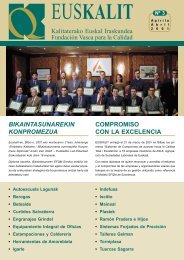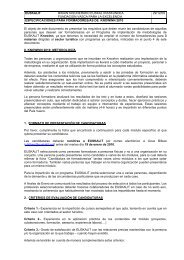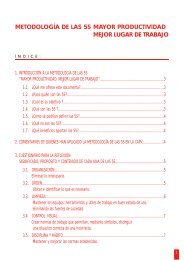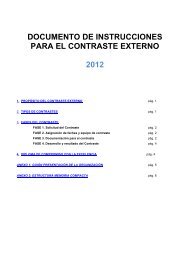Olabide Ikastola - Euskalit
Olabide Ikastola - Euskalit
Olabide Ikastola - Euskalit
Create successful ePaper yourself
Turn your PDF publications into a flip-book with our unique Google optimized e-Paper software.
2 STRATEGY strategy<br />
EFQM Excellence Award 2010 18<br />
2c. Strategy and supporting policies are developed, reviewed and<br />
Analyse relevant<br />
information and<br />
perform SWOT<br />
analysis<br />
Approve SP<br />
and BP<br />
Communicate<br />
SP and<br />
BP<br />
Review SEP,<br />
SCP and<br />
MVV<br />
Prepare budget<br />
for SP and BP<br />
Develop<br />
actions of<br />
the BP<br />
Identify or review the Strategic<br />
Priorities derived from the<br />
elements of the Mission-<br />
Vision.<br />
Monitor<br />
delivery<br />
of BP<br />
Draw up<br />
annual BP<br />
Draw up or<br />
refine SP<br />
Close BP<br />
and SP<br />
Fig.2c1: Flowchart for Strategy formulation<br />
Approach and deployment<br />
As explained in 2a and 2b, in <strong>Olabide</strong> we have identified and deployed<br />
a system of information sources designed to enable the<br />
MT to draw up and develop Strategy aligned to the <strong>Olabide</strong> MVV<br />
and based on external stakeholder needs, the external environment<br />
and the internal performance and capabilities of the school.<br />
The flowchart for drawing up Strategy is illustrated in Fig. 2c.1.<br />
Analysis of relevant information gathered<br />
All relevant information for strategy formulation is made available<br />
to the MT using the format and characteristics described in<br />
2a and 2b. The MT then subjects this information and data to<br />
SWOT analysis as the basis for drawing up or refining the existing<br />
Strategy Plan (SP), thus ensuring its alignment to the needs and<br />
expectations of all stakeholders.<br />
Review of basic documents<br />
Output from SWOT analysis is used by the MT for proposing<br />
possible refinements to the <strong>Olabide</strong> basic documents, i.e. the<br />
MVV, School Education Plan (SEP) and School Curricular Plan<br />
(SCP). The full pre-2009 <strong>Olabide</strong> Mission and Vision statements<br />
are presented in the Overview to this submission document, whilst<br />
the refined versions for the current SP 2009-12 are shown in the<br />
Qualification File (Dec. 2009). Pre-2009 Values are listed in 1a.<br />
The proposals of the MT are submitted to the GB for approval;<br />
if the GB approves the proposal, it then defines a calendar for this<br />
work to be done and appoints a team to manage it. This team,<br />
composed of cooperative member (parents) representatives and<br />
members of the MT, draws up draft reviews of each basic document<br />
and submits them to the GB and the Steering Committee<br />
for further discussion. On completion of this first stage, the draft<br />
versions are submitted to all teaching and non-teaching staff for<br />
them to put forward their contributions and suggestions to the<br />
Review Team, who then draw up an amended document to be<br />
submitted to the Assemblies of Class Representatives. Once the<br />
opinions and ideas of the class representatives have been taken<br />
into account, the final draft is provisionally approved and submitted<br />
to the General Assembly of Cooperative Members for their<br />
definitive approval. This cycle is repeated every 4 years, the latest<br />
review cycle having taken place in 2009, although interim reviews<br />
are occasionally conducted such as in 2006, when <strong>Olabide</strong> commitment<br />
to sustainability, environmental preservation and Corporate<br />
Social Responsibility was integrated into the documents.<br />
Over time, <strong>Olabide</strong> has had 4 Strategy Plans, with starting years<br />
of 1991, 1998, 2004 and 2009 respectively. In 2009, the MVV,<br />
<strong>Olabide</strong> statutes, SEP and Internal Rules and Regulations (IRR)<br />
were refined, whilst the SCP and the Employees’ Handbook are<br />
due to be reviewed in 2009-10. The SEP, which contextualises and<br />
supports the MVV and is deployed through the SCP, is refined<br />
on the basis of changes to the regulatory framework governing<br />
education. The SEP was also refined in 2007-08, in response to<br />
the application of the Spanish Fundamental Law of Education<br />
and the New Basque Curriculum, the review of which is due to<br />
be completed in <strong>Olabide</strong> by the end of 2009-10.<br />
Drawing up the SP and annual BP<br />
The SP 2004-09 was designed with a different approach from the<br />
previous one, the consequence of learning with the Overcall consultancy.<br />
The improvement consisted of drawing up the SP on 3<br />
levels and using 3 documents:<br />
• D1: the first level, identifying a series of elements derived from<br />
the Mission and Vision statements and determining the Critical<br />
Success Factors (CSF) for their delivery, their measurement and<br />
projected 4-year target values;<br />
• D2: a series of Strategic Priorities (StP) were associated with the<br />
previously identified Mission and Vision elements, taking into account<br />
the needs and expectations of all stakeholders and planned<br />
to be deployed over a 4-year time frame; and<br />
• D3: an annual Business Plan, determining a series of actions to<br />
be taken to deliver each strategic priority, the processes involved,<br />
a time frame for the actions and responsibility for their delivery.<br />
An extract is shown in Fig. 2c.3.<br />
An extract of D1 and D2 is shown in Fig. 2c.2. The draft BP is<br />
submitted every year to the GB for provisional approval in July,<br />
and is definitively approved in the first half of September and<br />
subsequently endorsed in the General Assembly of Cooperative<br />
Members. To maximise stakeholder participation in the formulation<br />
of the BP, the MT submits it to the GB and all teaching and<br />
non-teaching staff for their suggestions. BP activities, targets and<br />
indicators are agreed to on a consensus basis between the MT and<br />
all process owners, Management and Improvement Teams (MIT)<br />
and project leaders.<br />
With regard to ecological sustainability, <strong>Olabide</strong> has a clear social<br />
commitment to the environment. This is manifest through our involvement<br />
in the Bizi Zaitez Project to promote cycling (for both<br />
pupils and staff) as a means of transport to and from school, our<br />
commitment to the Agenda 21 Project, the actions taken in the<br />
school to reduce energy consumption (including sensor-activated<br />
lighting for a rational use of electricity) and equipping the school<br />
with solar panels as a renewable source of energy. This commitment<br />
was reflected in our MVV in 2006. All actions associated to<br />
people-related StP (3.1, 3.2, etc.) are designed to ensure societal<br />
sustainability, i.e. that our people’s efforts are sustainable and will<br />
not lead to burn-out.




